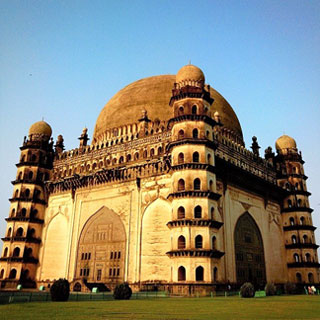Discover the Architectural Marvels of Bijapur: A Guide to Historic Wonders

Bijapur, historically known as Vijayapura, is renowned for its Kalyani Chalukyas architecture. Although the region was governed by various dynasties such as the Chalukyas, Hoysalas, Rashtrakutas, and Yadavas over seven centuries, the majority of the monuments in Bijapur were erected during the era of the Mughal Kings, including the Khiljis, Bahamanis, and Adil Shahs.
One notable architectural masterpiece is the Gol Gumbaz, visiting which offers a truly unique experience. Gol Gumbaz is a popular tourist destination that attracts visitors from both India and abroad throughout the year. Mohammed Adil Shah, along with his wives and daughters, are entombed here. Close to the Bijapur Railway station, the Gol Gumbaz complex includes the Naqarkhana—formerly the hall of trumpeters, now transformed into a museum by the Archaeological Survey of India, showcasing artifacts spanning various centuries, including ancient porcelain from China.
A well-maintained, lush lawn separates the Naqqarkhana from the main building of the Gol Gumbaz. Despite the influx of tourists daily, the cleanliness inside the Gol Gumbaz is remarkable. The monumental dome, surrounded by lotus petals and octagonal towers, are the architectural highlights of Gol Gumbaz.
Although devoid of ornate decorations, Gol Gumbaz is widely regarded as a geometric marvel of Deccan architecture. Its vast dome, measuring 144 feet in diameter, is an engineering feat and is considered the second-largest in the world, after St. Peter’s Basilica in Rome.
Visitors can ascend to the top via staircases to enjoy panoramic views of Bijapur. Early morning visits around 6 a.m. provide a chance to experience the tranquility of the ambiance and overhear whispers in the gallery, perhaps while observing hordes of parrots with striking red beaks.
Other significant sights in Bijapur include Ibrahim Rouza, Malik e-Maidan, Upli Burj, Jama Masjid, and Shivgiri, which are in excellent condition and popular among travellers.
Bijapur is a city that travellers fascinated by the rich history and culture of the Deccan Plateau should not miss.
How To Reach:
Air: Bijapur Airport is well connected with major cities of the state, facilitating easy access to various tourist destinations within the city.
Train: The Bijapur Railhead serves as a crucial juncture for trains from major cities. Prepaid taxis are readily available for local travel.
Road: Bijapur is well connected to other destinations in the state via an extensive road network. Local transport options are readily available for exploring the city; Gol Gumbaz is situated near the bus terminus.
Frequently Asked Questions (FAQs) About Bijapur
What is the main attraction in Bijapur?
The Gol Gumbaz is the main attraction in Bijapur, known for its architectural grandeur and engineering marvel. It is the second-largest dome in the world after St. Peter’s Basilica in Rome.
How can I reach Bijapur?
Air: Bijapur Airport is well connected with major cities in the state, making it convenient for travelers.
Train: The Bijapur Railhead is a crucial junction for trains from major cities. Prepaid taxis are available for local travel.
Road: Bijapur is well connected by an extensive road network. Local transport options are readily available for exploring the city.
What other significant sights should I visit in Bijapur?
Other notable attractions in Bijapur include Ibrahim Rouza, Malik e-Maidan, Upli Burj, Jama Masjid, and Shivgiri, all of which are in excellent condition and popular among travelers.
What makes Gol Gumbaz unique?
Gol Gumbaz is renowned for its vast dome measuring 144 feet in diameter, making it a geometric marvel of Deccan architecture. The whispering gallery is another unique feature where even the slightest sound can be heard across the dome.
When is the best time to visit Gol Gumbaz?
The best time to visit Gol Gumbaz is early in the morning around 6 a.m. to experience the tranquility and enjoy panoramic views of Bijapur without the crowds.